|
|
|
Sort Order |
|
|
|
Items / Page
|
|
|
|
|
|
|
| Srl | Item |
| 1 |
ID:
181680
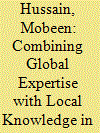

|
|
|
|
|
| Summary/Abstract |
This article traces the evolution of branded commodity advertising and consumption from corporeal health concerns to the racialisation of beauty through skin-lightening cosmetics in late colonial India. It centres two empirical foci: the marketing of personal hygiene products to Indian markets, and their racialised and gendered consumption. This article argues that the imperial economy tapped into and commodified ideals of cleanliness, beauty and fairness through marketing—ideals that continue to pervade contemporary South Asian communities. Contrary to claims that multinational corporations permeated Indian markets after the economic liberalisation of the late 1980s, there is a much deeper genealogy to the racialised imperial economy operating in European colonies. This article also examines the phenomenological underpinnings of imperial whiteness in colonial encounters to demonstrate how certain commodities appealed to Indians as ‘modern’ consumers, as well as how middle-class Indians and local entrepreneurs became active participants in the demand for, consumption and production of personal hygiene commodities.
|
|
|
|
|
|
|
|
|
|
|
|
|
|
|
|
| 2 |
ID:
181901


|
|
|
|
|
| Summary/Abstract |
Can traditional cultural practices thrive if they are commercialised? Or should the state protect them from “the market”? This study investigates these questions by studying the marketisation of traditional handicrafts in the tourism sector of Nanjing municipality (Jiangsu Province, China). Building on Boltanski and Esquerre’s (2020) work on the “enrichment economy,” I find that state-led marketisation efforts have simultaneously raised and distorted the value of intangible cultural heritage (ICH) commodities in China. Many ICH inheritors are stuck in the middle: although they benefit from enhanced recognition and valorisation of ICH products, they face difficulties in competing with “fake” and luxury ICH commodities. ICH commodities are thus characterised by an “in-between” status – between the enriched and the mass economy.
|
|
|
|
|
|
|
|
|
|
|
|
|
|
|
|
| 3 |
ID:
109619


|
|
|
|
|
| Publication |
2011.
|
| Summary/Abstract |
The main purpose of this article is twofold to analyze: (a) the long-term relation among the commodities prices and between spot electricity market price and commodity prices, and (b) the short-term dynamics among commodity prices and between electricity prices and commodity prices. Data between 2002 and 2005 from the Spanish electricity market was used. Econometric methods were used in the analysis of the commodity spot price, namely the vector autoregression model, the vector error correction model and the granger causality test. The co-integration approach was used to analyze the long-term relationship between the common stochastic trends of four fossil fuel prices. One of the findings in the long-term relation is that the prices of fuel and the prices of Brent are intertwined, though the prices of Brent ten to "move" to reestablish the price equilibrium. Another finding is that the price of electricity is explained by the evolution of the natural gas series.
|
|
|
|
|
|
|
|
|
|
|
|
|
|
|
|
| 4 |
ID:
129927
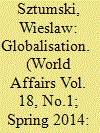

|
|
|
|
|
| Publication |
2014.
|
| Summary/Abstract |
In theory, globalisation increases the production of commodities and ensures a greater number of jobs, thereby improving people's lives in both developed and developing countries. Wieslaw Sztumski however avers that it does not resolve conflicts or eradicate economic and social inequalities while it may reduce human freedom and security. Moreover, globalisation contains both known and unknown risks and dangers.
|
|
|
|
|
|
|
|
|
|
|
|
|
|
|
|
| 5 |
ID:
121849


|
|
|
|
|
| Publication |
2013.
|
| Summary/Abstract |
Maritime piracy is a growing scourge on the international community-imposing large costs on maritime states and the shipping industry, as well as potentially undermining state capacity and funding terrorism. Using original data on over 3,000 pirate attacks, the authors argue that these attacks are, in part, a response to poor labor market opportunities. To establish this, the authors take advantage of the strong effect of commodity prices on labor market opportunities in piracy-prone states. Consistent with this theory, the authors show that changes in the price of labor- and capital-intensive commodities have consistent and strong effects on the number of pirate attacks in a country's territorial waters each month. The authors confirm these results by instrumenting for commodity prices using monthly precipitation levels.
|
|
|
|
|
|
|
|
|
|
|
|
|
|
|
|
| 6 |
ID:
156295
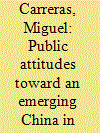

|
|
|
|
|
| Summary/Abstract |
In the past two decades, China has substantially increased its economic presence in Latin America. The impressive rate of economic growth in China has resulted in a voracious appetite for Latin American commodities and energy sources. China has also become a major investor in the region, and has loaned billions of dollars to Latin American countries. This paper evaluates how aware Latin American citizens are of this increased economic presence of China, and also studies citizens’ attitudes toward the rising influence of China in Latin America. Public attitudes toward the Chinese economic and political model, and evaluations of the Chinese popular culture are also presented and discussed. The evidence suggests that the image of China is improving in Latin America as a result of its new economic role in the region. However, Chinese soft power faces several limitations in the region. The Chinese political and economic models, and the Chinese popular culture are still not very attractive in Latin America.
|
|
|
|
|
|
|
|
|
|
|
|
|
|
|
|
| 7 |
ID:
147761
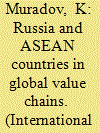

|
|
|
|
|
| Summary/Abstract |
USE OF TRADE STATISTICS is a normal way to evaluate economic cooperation between nations. Member countries of the Association of Southeast Asian Nations (ASEAN) are the destination of 1.8% of Russian exports and the source of 3.9% of imports into Russia.* Russia is the recipient of 0.4% of the total exports of the ASEAN countries and the source of 1.4% of their total imports.1 At first sight, these are modest statistics. But do they accurately reflect the nature of economic relations between, and the interdependence of, Russia and ASEAN nations in today's globalized world?
|
|
|
|
|
|
|
|
|
|
|
|
|
|
|
|
| 8 |
ID:
151500
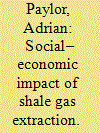

|
|
|
|
|
| Summary/Abstract |
This article explores the global social–economic impact of shale gas extraction, comparing the differing social and economic impacts shale gas extraction may have on communities in developed and developing countries. It argues that the benefits of fracking are more likely to be enjoyed by communities in highly and very highly developed countries rather than by those in countries with low or medium levels of development . Additionally, it shows that the potential risks and drawbacks of shale gas and its extraction are more likely to be experienced by communities in these latter countries than by those in highly or very highly developed countries. However, it also demonstrates that even communities in developed countries are vulnerable to environmental and health risks associated with shale gas extraction.
|
|
|
|
|
|
|
|
|
|
|
|
|
|
|
|
| 9 |
ID:
097339
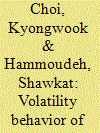

|
|
|
|
|
| Publication |
2010.
|
| Summary/Abstract |
This study supplements previous regime-switching studies on WTI crude oil and finds two possible volatility regimes for the strategic commodity prices of Brent oil, WTI oil, copper, gold and silver, and the S&P 500 index, but with varying high-to-low volatility ratios. The dynamic conditional correlations (DCCs) indicate increasing correlations among all the commodities since the 2003 Iraq war but decreasing correlations with the S&P 500 index. The commodities also show different volatility persistence responses to financial and geopolitical crises, while the S&P 500 index responds to both financial and geopolitical crises. Implications are discussed.
|
|
|
|
|
|
|
|
|
|
|
|
|
|
|
|
|
|
|
|
|